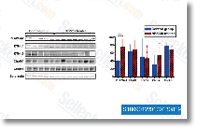indigotica, and also meets the rising marketplace needs. Metabolic engineering approaches have emerged like a really impressive tool for increasing the production of beneficial compounds in plants. With in depth comprehending of biosynthesis, the information of important compounds is dramat ically improved by bio engineering approaches in lots of medicinal plants as Catharanthus roseus, Hyoscyamus niger, and Salvia miltiorrhiza, However, because of the limited information of biosynthesis pathways, there is no prosperous progress on metabolic engineering in I. indigotica right up until now. As a result, a deep knowing of the biosynthetic pathways in the many compounds produced from the plant gets to be the 1st imperative. Like a non model plant species, minor info was initially offered to achieve this purpose.
In previous research, the genes concerned in lignan synthesis had been isolated selleck inhibitor and character ized, together with PAL, C4H, 4CL, CCR, CAD, C3H, CCoAOMT, and PLR by homologous cloning, Nevertheless, the slow process of homologous cloning has afforded only restricted progress toward a full understanding of these various, biosynthetic pathways in I. indigotica. Nearly all of genes concerned in secondary metabolites synthesis and the corresponding regulatory genes for these active com pounds nonetheless stay unclear. To obtain a standard database of genes, 454 RNA deep sequencing was employed in an effort to assess the tran scriptome of I. indigotica. By this de novo method, it was doable to recognize a set of putative genes concerned within the pathways of secondary metabolism, particularly those genes related to the biosynthesis of your valuable active compounds.
The aim within this research was to establish a candidate gene pool of I. indigotica, and to assist within the discovery selleck chemical of new genes related to the secondary metabolic pathways. Meanwhile, metabolite evaluation was carried out following the indications offered through the transcriptome. Integrated evaluation from the transcriptome and the secondary metabolites will result in an in depth understanding of both the pool of metabolites and biosynthetic processes for your formation on the active compounds in I. indigotica. Techniques Plant materials and induction The plant of I. indigotica was grown in the medicinal plant backyard with the 2nd Military Healthcare University, Shanghai, China, and was recognized by Professor Hanming Zhang. The organs of flowering plantlets, which includes flowers, leaves, stems, and roots have been col lected, respectively in April, and frozen instantly in liquid  nitrogen for storage at 80 C. The I. indigotica hairy root cultures had been maintained and sub cultured in this laboratory. The hairy root material was cultured in 200 mL of 1 2 B5 liquid medium at pH 5.
nitrogen for storage at 80 C. The I. indigotica hairy root cultures had been maintained and sub cultured in this laboratory. The hairy root material was cultured in 200 mL of 1 2 B5 liquid medium at pH 5.
Microrna Synthesis
MiRNAs are abundant in many mammalian cell types.
